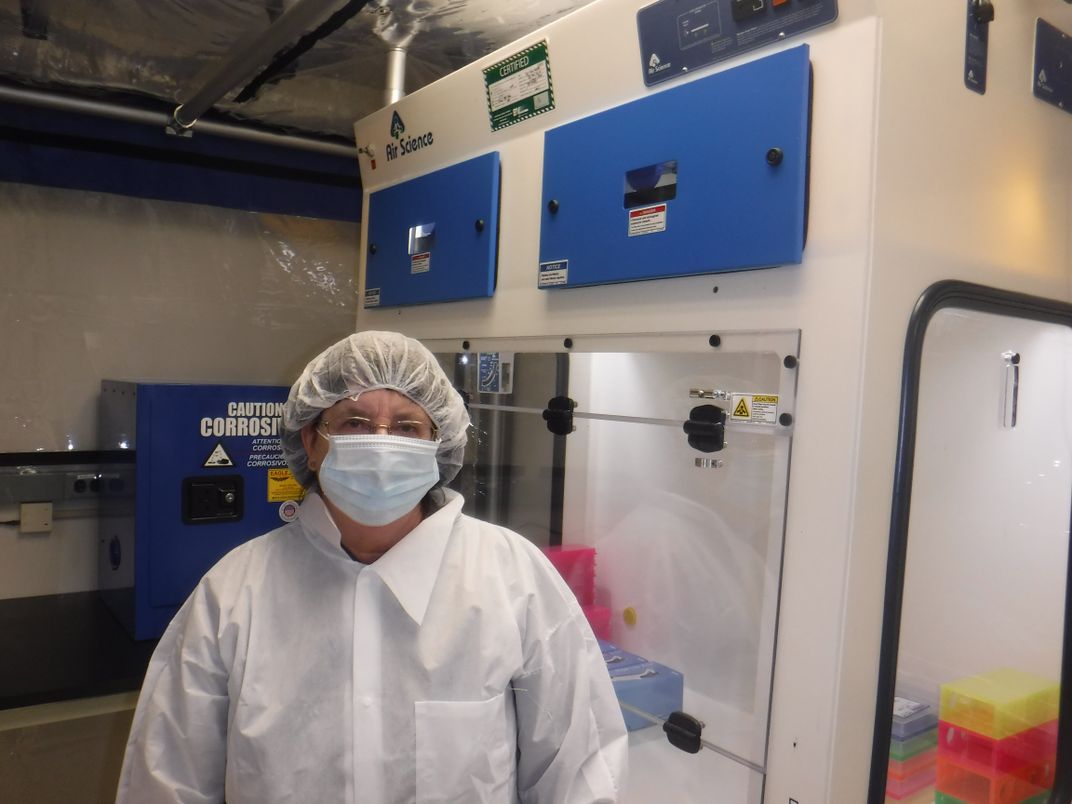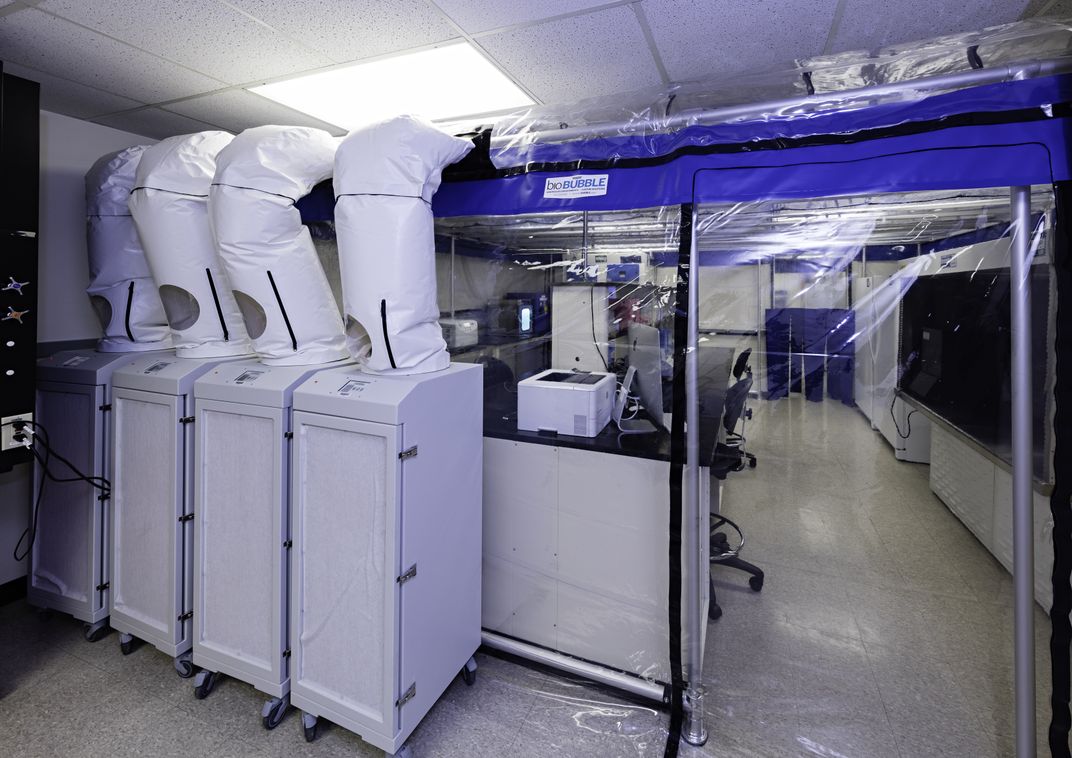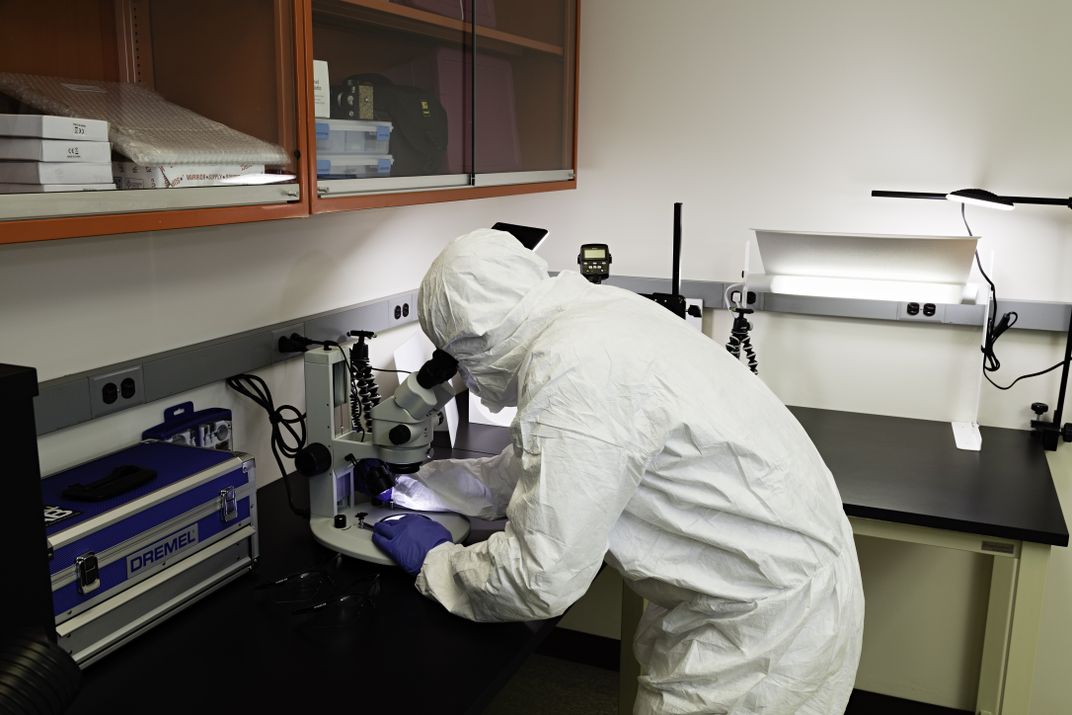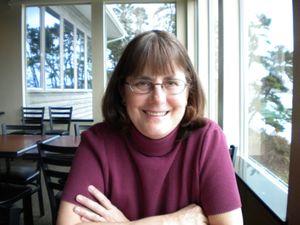NATIONAL MUSEUM OF NATURAL HISTORY
Safety Suit Up: New Clean Room Allows Scientists to Study Fragile Ancient DNA
A new lab at the Smithsonian’s National Museum of Natural History allows scientists to process and study ancient DNA.
/https://tf-cmsv2-smithsonianmag-media.s3.amazonaws.com/blogging/featured/NMNH-2018-00197.jpg)
Go straight to your destination. Do not enter any other labs or offices prior to coming. Proceed toward POD 5.
It sounded like I was heading to a space capsule but, in reality, I was on my way to a tour of the new BioBubble lab in Suitland, Maryland, specifically created for ancient DNA research.
Pod 5 is part of the National Museum of Natural History’s portion of the Smithsonian’s Museum Support Center (MSC). It provides the optimum conditions for the preservation and study of the Smithsonian’s 25 million biological specimens preserved in fluids known as the “wet collections.” There are actually five PODs approximately the size of a football field and rising to about 28 feet in height at the complex. They contain space and storage for Smithsonian research and collections and are surrounded by many labs and offices.
Upon my arrival, I scanned my Smithsonian ID badge at the security desk and passed into the building that is closed to the public. At the appointed time, I joined four other Smithsonian staff members awaiting the only internal tours before researchers begin work in the lab.
After walking down a cavernous hallway, my group stopped at a sign-in desk and dropped off our coats and packs. Picture-taking was a high priority, but after learning that cameras would be wiped down with bleach, the others decided to leave their phones behind. Luckily, I brought an underwater camera used during my last vacation so I allowed it to be swabbed and took it on the tour.

We continued to the anteroom of the lab where personnel greeted us and diverted the group into a closet-sized prep room stocked with protective lab attire. Here, we donned plastic gloves, hair nets, face masks, and disposable lab coats with stretch cuffs. Teetering, we attempted to put on shoe covers without the aid of a bench.
Passing into the lab, I saw a vinyl strip-shield curtain flapping lightly outward; a sign of positive air pressure. With my facemask over my nose, my glasses began to fog up, but I knew I was following protocol for entering an ancient DNA laboratory. All these precautions were not to protect me, but to protect the “clean room” from hitchhiking DNA from my breath, skin, hair, and nonsterile pieces of clothing.
“It took a year of planning to create this 17’ by 17’ soft wall containment lab with the help of the BioBubble company from Colorado,” explained Jeffrey Hunt, the lab manager. “We first [measured] the lab space and then we designed the aluminum framework and vinyl skin bubble to fit in that space.”

Logan Kistler, Curator of Archaeology in the Anthropology department at the Smithsonian’s National Museum of Natural History, explained that ancient DNA (aDNA) is extracted from naturally preserved plants as well as from archeological skeletons, mummified tissue, and tissue remains found in ice and permafrost. Bone and teeth, he noted, are a better source of aDNA than soft tissue.
How old is ancient DNA? Michael G. Campana, of the Smithsonian’s Center for Conservation Genomics explained that the practical limit of ancient DNA survival is approximately 1 million years old. Unfortunately for now, this excludes dinosaur aDNA as the last of these reptiles died around 65 million years ago. But it does include aDNA from a 700,000-year-old horse’s bone fragments from the Yukon Territory and 430,000-year-old aDNA from early human fossils found in Spain, among other specimens.
DNA carries genetic code that determines all the characteristics of a living thing. In our bodies, DNA carries a trait such as eye color that can be passed down through generations. So, when scientists in the BioBubble lab examine the aDNA of a specimen, they are trying to identify the genes for its specific traits. Working with different specimens over time, scientists can learn how specimens differ genetically and how they are evolutionarily related.
Beth Shapiro, co-director of the Paleogenomics Lab at the University of California, Santa Cruz, noted that studying aDNA may even identify genes for traits that don’t exist anymore. She found that analyzing aDNA is a powerful technique for learning about the evolutionary process that shaped existing biodiversity.
One such example is the research done by Graham J. Slater, a former Peter Buck Fellow at the Smithsonian, and others that compared the aDNA from skins of a now extinct species, the Caribbean monk seal, to the Hawaiian monk seal. Based on the analysis of the species’ evolutionary development and the ability to date the time of divergence between the lineages, the team found the formation of the Panamanian Isthmus led to the creation of the two-distinct species. Yet more importantly, knowing the Caribbean monk seals’ extinction was caused by unrestricted hunting and that by the end of 2016 only 1,400 Hawaiian Monk seals existed, it is vital that conservation efforts continue and expand to preserve the evolutionary lineage of this endangered species.
Unfortunately, the quality of aDNA differs from modern DNA. Long strands of aDNA break in to increasingly smaller fragments over time, and ancient tissues are susceptible to environmental contamination which can come from bacteria, fungus, or even plant cells from a root that embedded itself into the remains. Certain enzymes can also break down DNA, even after the cell dies.

How do lab scientists cope with these issues? They use new methods to prevent the contamination by extracting aDNA samples in sterile conditions such as in the BioBubble clean room. Next, they use a versatile tool—Next Generation Sequencing—that performs sequencing of millions of small fragments of DNA in parallel, taking advantage of degraded fragments like those found in aDNA. Collecting and analyzing this complex biological data, scientists piece together these fragments through mapping and approximate rates of contamination then send the data to a national database.
The biggest threat to the successful operation of the BioBubble lab is contamination of aDNA. Scientists entering the lab wear hazmat suits and two pairs of gloves. That way, if chemicals or aDNA get on the outer gloves, they can remove them and still keep their own DNA locked inside a barrier until they put on a new pair. Recordkeeping is done in notebooks and computers that stay in the lab. The chemicals used to extract and analyze aDNA must also be contaminate free. Kistler explained that all the equipment is periodically wiped down with bleach and applications of ultraviolet lights to disinfect the area. A HEPA-filter purifies the air entering the room and the positive pressure prevents incoming unfiltered air.
Although it is not large, researchers welcome the facility. Kistler and other scientists are able to take a close look at very old museum specimens and any truly ancient DNA. As scientists extract and analyze ancient DNA, they will be looking through a window to the past to see how and when species evolved in changing environmental conditions. With labs like the BioBubble, scientists may one day be able to develop successful biodiversity conservation strategies.

